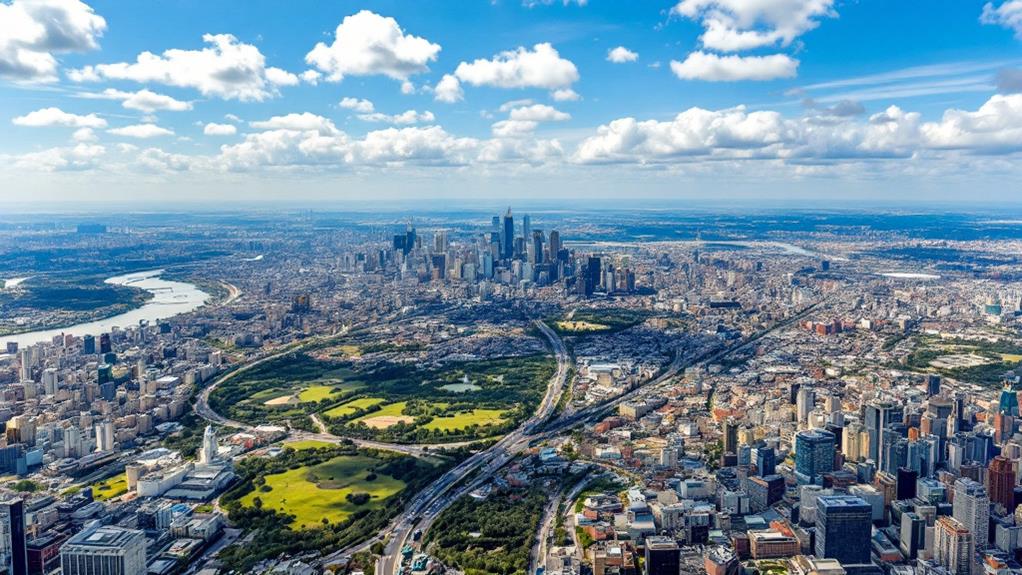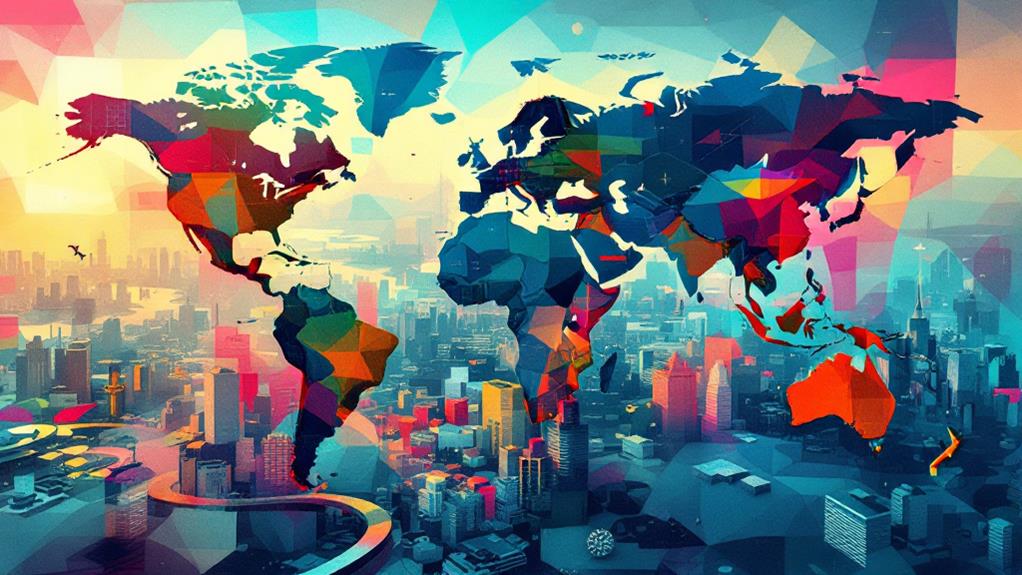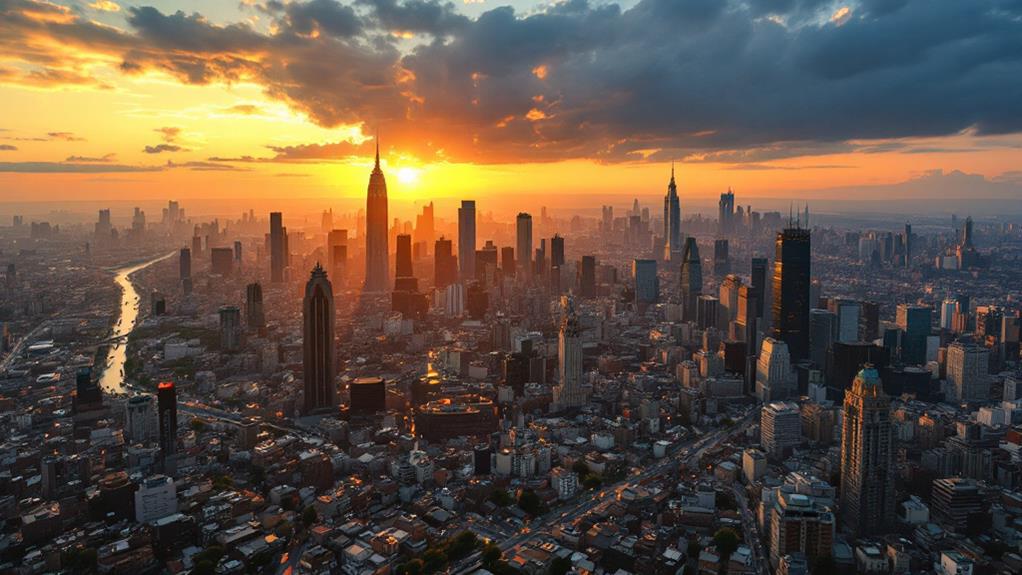Largest Urban Areas by Land Size: A Look at the World's Sprawling Cities

When you think of sprawling cities, New York tops the list in the U.S. with an expansive 4,669 square miles, followed by the Boston-Providence corridor. Surprisingly, eight of the world's largest urban areas by land size are in America. However, Tokyo-Yokohama is known for packing 38 million residents into a denser space, showcasing a different kind of urban expanse. Across the globe, the Pearl River Delta has seen explosive population growth, from 10 million in 1988 to 42 million in 2014. These cities illustrate the balance and challenges of urban sprawl, and there's more to uncover about their impact.
Leading Urban Giants
In regard to urban giants, size truly matters. When you investigate the largest urban areas by land size, the New York-New Jersey-Connecticut metropolitan area stands out prominently. Spanning an impressive 4,669 square miles, it's the most extensive urban sprawl in the United States. This vast region exemplifies significant urban growth and complex land use patterns. Right behind it, the Boston-Providence area covers 3,683 square miles, claiming the second spot in land size. Such sprawling regions often come with challenges, including managing infrastructure and maintaining sustainable development.
The U.S. clearly dominates these rankings, with eight out of the ten largest urban areas by land size situated within its borders. This showcases how land use strategies are essential in handling the expansion and growth of these areas. In contrast, the Tokyo-Yokohama metro area, though not the largest by land, boasts the highest population density worldwide, housing 38 million people. This highlights how urban growth can manifest differently, prioritizing efficient land use over sheer land size. As you investigate these urban giants, you'll notice the intricate balance between land size, population density, and sustainable metropolitan development.
Urbanization Trends Worldwide
Across the globe, urbanization is reshaping landscapes and lifestyles, particularly in Asia, where cities like the Pearl River Delta are experiencing explosive growth. This region's transformation from rural to urban illustrates how rapidly metropolitan areas can evolve. With its population skyrocketing from 10 million in 1988 to 42 million in 2014, the Pearl River Delta has surpassed even Tokyo regarding population and land area. This rapid urbanization presents both opportunities and challenges, especially in infrastructure and environmental sustainability.
In contrast, American cities often exhibit larger land areas but don't experience the same population growth as their Asian counterparts. Urban sprawl is a significant issue, especially in places like Atlanta and Houston, where low population density shapes the American landscape. This sprawl brings about unique challenges concerning infrastructure and housing demand, putting pressure on suburban areas to accommodate growing needs.
Globally, as cities continue to grow, both in size and number, the challenge remains balancing development with environmental sustainability. With continued urbanization, the focus must shift towards creating resilient metropolitan areas that prioritize efficient infrastructure and sustainable practices to support burgeoning populations.
Infographics and Visual Data

Urbanization's impact on global landscapes and lifestyles demands effective ways to communicate complex data. Infographics serve as powerful tools, providing clear visual representations of urban sprawl. Platforms like Statista offer these infographics, showcasing critical statistics such as land area, population density, and transportation trends. For instance, the World Urban Areas Report by Demographia compiles demographic data that can be visually depicted to show urbanization patterns and Smart Growth strategies.
The differences in land area among sprawling cities are substantial, with New York-New Jersey-Connecticut, spanning 4,669 square miles, as the largest urban area. Infographics illustrate these vast differences, making it easier to grasp the scale of urban sprawl. They also highlight how urbanization affects transportation trends, often resulting in traffic congestion and a rise in personal vehicle use.
Customizable infographic options allow you to present urbanization statistics tailored to specific needs. This flexibility helps you convey complex data about sprawling cities in a more digestible format, enhancing understanding of urban trends. By leveraging infographics, you can better appreciate the intricacies of urban growth and the ongoing challenges associated with it, leading to more informed decisions and discussions on Smart Growth.
Transportation Innovations
With cities expanding rapidly, transportation innovations are fundamental to keeping urban centers moving smoothly. As urban sprawl continues, sprawling cities face significant mobility challenges. Innovations like autonomous vehicles and robotaxis are reshaping urban mobility, offering potential solutions to reduce traffic congestion. Self-driving cars could become pivotal in easing the gridlock that often plagues these vast urban areas. However, safety concerns remain a focus as this technology evolves.
In major Asian cities, high-speed rail projects are being implemented to improve transit efficiency and reduce reliance on personal vehicles. These projects offer a glimpse into the future of urban transportation, where public transportation systems are crucial for sustainable urban expansion. For many Americans, especially in sprawling cities, access to reliable public transit is limited. Over 55% lack access, highlighting the need for increased investment in public transportation infrastructure.
In the U.S., a decline in passenger car ownership among younger generations points to a shift towards alternative transportation methods. This trend underscores the significance of developing diverse transit options that address urban mobility challenges. As urban areas grow, embracing these transportation innovations will be essential to maintaining efficient and sustainable cities.
Economic and Social Impacts

Contributing considerably to national GDP, sprawling urban areas showcase both economic growth and stark challenges. As these cities expand, they drive economic growth by creating jobs and attracting investment. However, they also face the economic burden of urban sprawl, which costs over $1 trillion annually. This includes maintaining infrastructure and delivering public services efficiently. You'll notice that housing markets in sprawling metropolitan areas often see sharp price increases, especially as demand for single-family homes and land in suburban regions rise.
Transportation costs are another significant issue in these urban sprawls. Many residents rely on personal vehicles due to limited public transit, leading to transportation costs consuming 20-25% of household income. This reliance on cars extends commuting times and contributes to environmental concerns. Social implications of urban sprawl are also prevalent, as disparities in access to services and amenities can lead to potential social isolation. In suburban regions, you might find that these issues exacerbate, with residents facing longer commutes and limited access to crucial public services. Addressing these challenges requires a balanced approach to urban planning that considers both economic and social impacts to improve living conditions.



